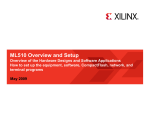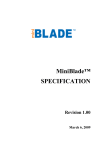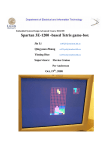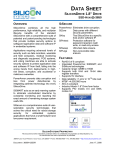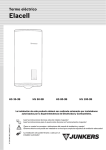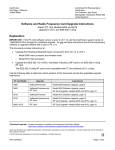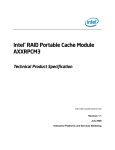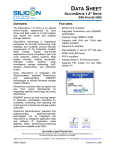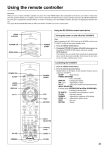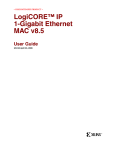Download ML501 Overview and Setup
Transcript
ML501 Overview and Setup Overview of the Hardware Designs and Software Applications How to set up the equipment, software, CompactFlash, network, and terminal programs May 2008 ML501 Overview • • • • • • • ML501 Overview Equipment Overview Equipment Setup Software Setup CompactFlash Setup Network Setup Appendix ML501 Overview • The ML501 embedded development platform provides several reference designs and a versatile hardware platform for rapid prototyping and system verification • Hardware Designs – – – – ml501_bsb_design ml501_bsb_std_ip ml501_bsb_std_ip_usb ml501_std_ip_pcores • Software Applications – Standalone non-OS applications ML501 BSB Hardware • The ML501 MicroBlaze design hardware includes: – DDR2 Interface (256 MB) – BRAM – External Memory Controller (EMC) • ZBT SRAM – – – – – – Networking UART Interrupt Controller System ACE CF Interface GPIO (IIC, LEDs and LCD) PLB Arbiter Note: Presentation applies to the ML501 Also Available From Xilinx • These items are not included with the ML501, but are available for purchase from Xilinx: – Xilinx Integrated Software Environment (ISE) – Xilinx Platform Studio (XPS) – Parallel Cable IV (PC4) JTAG cable • These items are required to run the ML501 presentations ML501Details • The ML501 Board – Zoom in for a better view (up to 400%) • Features the Xilinx Virtex™-5 XC5VLX50 FPGA ML501Details Equipment Overview • SiliconDrive™ 32 MB CompactFlash™ – Comes preloaded with hardware and software demonstration systems for ML501 Equipment Overview • SanDisk ImageMate™ (optional) – Provides a USB interface for programming CompactFlash cards – See www.sandisk.com for more information • SanDisk PC Card adapter (optional) – Used in a laptop PCMCIA slot to program CompactFlash cards Equipment Overview • DVI monitor or • DVI to VGA adapter – To connect from the ML501 DVI port to a standard VGA monitor – http://www.belkin.com • Pancake Fan (optional) – Recommended for cooling the Virtex-5 device on the ML501 board Equipment Setup • Set Front DIP Switches to 00010101 (1) 1 Equipment Overview • User supplied – null modem serial cable • Ethernet cross-over cable – Similar to a null-modem for Ethernet Equipment Setup • Connect Ethernet, DVI, and a USB Keyboard to ML501 Software Setup • Install a terminal program, such as Tera Term Pro, or use the HyperTerminal program included with Microsoft Windows – Required to input the commands, and view the results • See the appendix for details on terminal programs and setup Remove the CompactFlash • When using a PC Card Adapter, the card must be properly stopped before the it is removed from your PC – Click on the Unplug or Eject Hardware icon in your system tray (1) – Stop the PCMCIA controller (2) 1 2 CompactFlash Setup • Some devices, such as the SanDisk ImageMate, do not need to be stopped, but the CompactFlash must still be properly ejected • Perform a software eject on the CompactFlash before removing it from the SanDisk ImageMate – In the My Computer window, right click on Removable Disk and select Eject to remove it from your PC – This insures that data will be written to it CompactFlash Setup • Insert the CompactFlash provided with the ML501 fully into the CompactFlash slot on the ML501 board Network Setup • Click Start → Settings → <Right Click> Network Connections → Open Right Click Here Network Setup • In the Network Connections, right-click on the Ethernet Adapter and select Properties (1) 1 Network Setup • Set your host (PC) to this IP Address: Note: Some presentations use other IP addresses; change as directed Network Setup • Click Configure (1) – Set the Media Type to Auto for 1 Gbps 1 Note: ML501 QuickStart uses 100Mb Full Browser Setup • The lwip/webserver demo requires the browser used (Firefox shown) to have a direct connection to the internet Appendix • Terminal Programs – Tera Term – Hyperterminal • Creating Desktop Shortcuts Terminal Programs • Terminal programs are used to communicate with the processor • Terminal programs in this setup use a serial interface • Two free programs are available – Tera Term Pro (recommended) • More flexible than HyperTerminal • See http://hp.vector.co.jp/authors/VA002416/teraterm.html – HyperTerminal (comes with Windows) Tera Term Pro • Default startup mode • Select the serial port that you connected your cable to Tera Term Pro • Set the serial port parameters – – – – – 9600 baud 8 Data Bits No Parity One Stop Bit No Flow Control Tera Term Pro • Click Setup → Terminal… to increase the window size Tera Term Pro • Click Setup → Window… to increase the buffer size (to view more lines) Tera Term Pro • Click Setup → Save setup… to save the terminal window setup Tera Term Pro • To automatically restore the command line options – Use “/F=<file name>.ini” • To automatically open a log file – Use “/L=<log file>.log” HyperTerminal • Upon starting, you are prompted to create a new connection HyperTerminal • Set the serial port parameters – 9600 baud – Same settings 8-N-1, No flow control • Save the new connection HyperTerminal • Your new connection will appear in the start menu Start → Accessories → Communications → HyperTerminal → <name> HyperTerminal • After creating the connection, you can expand the buffer size (if desired) – The buffer setting must be set each time • You can create a log file by selecting Transfer → Capture Text Desktop Shortcuts • You can add shortcuts to your desktop for either Tera Term Pro or HyperTerminal – This works especially well for Tera Term Pro since the command line options can be added here – You can create different shortcuts to run the desired speed as seen below Desktop Shortcuts • Right-click on your desktop and select New → Shortcut • Browse for the terminal program folder Desktop Shortcuts • For Tera Term Pro, link to the ttermpro.exe program file: C:\Program Files\TTERMPRO\ttermpro.exe Desktop Shortcuts • Name the Tera Term Pro shortcut • Add the command line options • Click OK Desktop Shortcuts • For HyperTerminal, locate the .ht files C:\Documents and Settings\<user name>\Start Menu\Programs \Accessories\Communications\HyperTerminal Desktop Shortcuts • Name the HyperTerminal shortcut • Click Finish – There are no command line options Documentation • Virtex-5 – Silicon Devices http://www.xilinx.com/products/silicon_solutions – Virtex-5 Multi-Platform FPGA http://www.xilinx.com/products/silicon_solutions/fpgas/virtex/virtex5 – Virtex-5 Family Overview: LX, LXT, SXT, and FXT Platforms http://www.xilinx.com/support/documentation/data_sheets/ds100.pdf – Virtex-5 FPGA DC and Switching Characteristics Data Sheet http://www.xilinx.com/support/documentation/data_sheets/ds202.pdf Documentation • Virtex-5 – Virtex-5 FPGA User Guide http://www.xilinx.com/support/documentation/user_guides/ug190.pdf – Virtex-5 FPGA Configuration User Guide http://www.xilinx.com/support/documentation/user_guides/ug191.pdf – Virtex-5 System Monitor User Guide http://www.xilinx.com/support/documentation/user_guides/ug192.pdf – Virtex-5 Packaging and Pinout Specification http://www.xilinx.com/support/documentation/user_guides/ug195.pdf Documentation • Design Resources – ISE Development Tools and IP http://www.xilinx.com/ise – Integrated Software Environment (ISE) Foundation Resources http://www.xilinx.com/ise/logic_design_prod/foundation.htm – ISE Manuals http://www.xilinx.com/support/software_manuals.htm – ISE Development System Reference Guide http://toolbox.xilinx.com/docsan/xilinx10/books/docs/dev/dev.pdf – ISE Development System Libraries Guide http://toolbox.xilinx.com/docsan/xilinx10/books/docs/virtex5_hdl/virtex5_hdl.pdf Documentation • Additional Design Resources – Customer Support http://www.xilinx.com/support – Xilinx Design Services: http://www.xilinx.com/xds – Titanium Dedicated Engineering: http://www.xilinx.com/titanium – Education Services: http://www.xilinx.com/education – Xilinx On Board (Board and kit locator): http://www.xilinx.com/xob Documentation • Platform Studio – Embedded Development Kit (EDK) Resources http://www.xilinx.com/edk – Embedded System Tools Reference Manual http://www.xilinx.com/support/documentation/sw_manuals/edk10_est_rm.pdf – EDK Concepts, Tools, and Techniques http://www.xilinx.com/ise/embedded/edk92i_docs/edk_ctt.pdf Documentation • MicroBlaze – MicroBlaze Processor http://www.xilinx.com/microblaze – MicroBlaze Processor Reference Guide – UG081 http://www.xilinx.com/support/documentation/sw_manuals/mb_ref_guide.pdf Documentation • ChipScope Pro – ChipScope Pro 10.1i Serial IO Toolkit User Manual http://www.xilinx.com/ise/verification/chipscope_pro_siotk_10_1_ug213.pdf – ChipScope Pro 10.1i ChipScope Pro Software and Cores User Guide http://www.xilinx.com/ise/verification/chipscope_pro_sw_cores_10_1_ug029.pdf Documentation • Memory Solutions – Demos on Demand – Memory Interface Solutions with Xilinx FPGAs http://www.demosondemand.com/clients/xilinx/001/page_new2/index.asp#35 – Xilinx Memory Corner http://www.xilinx.com/products/design_resources/mem_corner – Additional Memory Resources http://www.xilinx.com/support/software/memory/protected/index.htm – Xilinx Memory Interface Generator (MIG) 2.1 User Guide http://www.xilinx.com/support/software/memory/protected/ug086.pdf – Memory Interfaces Made Easy with Xilinx FPGAs and the Memory Interface Generator http://www.xilinx.com/support/documentation/white_papers/wp260.pdf Documentation • Ethernet – Virtex-5 Embedded Tri-Mode Ethernet MAC Wrapper Data Sheet http://www.xilinx.com/support/documentation/ip_documentation/ v5_emac_ds550.pdf – Virtex-5 Embedded Tri-Mode Ethernet MAC Wrapper Getting Started Guide http://www.xilinx.com/support/documentation/ip_documentation/ v5_emac_gsg340.pdf – Virtex-5 Tri-Mode Ethernet Media Access Controller User Guide http://www.xilinx.com/support/documentation/user_guides/ug194.pdf – LightWeight IP (lwIP) Application Examples – XAPP1026 http://www.xilinx.com/support/documentation/application_notes/xapp1026.pdf Documentation • PLB v4.6 IP – Processor Local Bus (PLB) v4.6 Data Sheet – DS531 http://www.xilinx.com/support/documentation/ip_documentation/plb_v46.pdf – Multi-Port Memory Controller (MPMC) – DS643 http://www.xilinx.com/support/documentation/ip_documentation/mpmc.pdf – XPS Multi-CHannel External Memory Controller (XPS MCH EMC) – DS575 http://www.xilinx.com/support/documentation/ip_documentation/ xps_mch_emc.pdf – XPS LocalLink TEMAC – DS537 http://www.xilinx.com/support/documentation/ip_documentation/xps_ll_temac.pdf – XPS LocalLink FIFO – DS568 http://www.xilinx.com/support/documentation/ip_documentation/xps_ll_fifo.pdf Documentation • PLB v4.6 IP – XPS IIC Bus Interface – DS606 http://www.xilinx.com/support/documentation/ip_documentation/xps_iic.pdf – XPS SYSACE (System ACE) Interface Controller – DS583 http://www.xilinx.com/support/documentation/ip_documentation/xps_sysace.pdf – XPS Timer/Counter – DS573 http://www.xilinx.com/support/documentation/ip_documentation/xps_timer.pdf – XPS Interrupt Controller – DS572 http://www.xilinx.com/support/documentation/ip_documentation/xps_intc.pdf – Using and Creating Interrupt-Based Systems Application Note http://www.xilinx.com/support/documentation/application_notes/xapp778.pdf Documentation • PLB v4.6 IP – XPS General Purpose Input/Output (GPIO) – DS569 http://www.xilinx.com/support/documentation/ip_documentation/xps_gpio.pdf – XPS External Peripheral Controller (EPC) – DS581 http://www.xilinx.com/support/documentation/ip_documentation/xps_epc.pdf – XPS 16550 UART – DS577 http://www.xilinx.com/support/documentation/ip_documentation/ xps_uart16550.pdf – PLBV46 to DCR Bridge Data Sheet – DS578 http://www.xilinx.com/support/documentation/ip_documentation/ plbv46_dcr_bridge.pdf Documentation • IP – Local Memory Bus Data Sheet – DS445 http://www.xilinx.com/support/documentation/ip_documentation/lmb_v10.pdf – Block RAM Block Data Sheet – DS444 http://www.xilinx.com/support/documentation/ip_documentation/bram_block.pdf – Microprocessor Debug Module Data Sheet – DS641 http://www.xilinx.com/support/documentation/ip_documentation/mdm.pdf – LMB Block RAM Interface Controller Data Sheet – DS452 http://www.xilinx.com/support/documentation/ip_documentation/ lmb_bram_if_cntlr.pdf – Device Control Register Bus (DCR) v2.9 Data Sheet – DS406 http://www.xilinx.com/support/documentation/ip_documentation/dcr_v29.pdf Documentation • IP – JTAGPPC Controller Data Sheet – DS298 http://www.xilinx.com/support/documentation/ip_documentation/jtagppc_cntlr.pdf – Processor System Reset Module Data Sheet – DS402 http://www.xilinx.com/support/documentation/ip_documentation/ proc_sys_reset.pdf – Clock Generator v2.0 Data Sheet – DS614 http://www.xilinx.com/support/documentation/ip_documentation/ clock_generator.pdf – Util Bus Split Operation Data Sheet – DS484 http://www.xilinx.com/support/documentation/ip_documentation/ util_bus_split.pdf Documentation • ML501 – ML501 Overview http://www.xilinx.com/ml501 – ML501 Evaluation Platform User Guide – UG226 http://www.xilinx.com/support/documentation/boards_and_kits/ug226.pdf – ML501 Reference Design User Guide – UG227 http://www.xilinx.com/support/documentation/boards_and_kits/ug227.pdf – ML501 Getting Started Tutorial – UG228 http://www.xilinx.com/support/documentation/boards_and_kits/ug228.pdf Documentation • ML501 – ML501 Schematics http://www.xilinx.com/support/documentation/boards_and_kits/ ml501_20061010_bw.pdf – ML501 Bill of Material http://www.xilinx.com/support/documentation/boards_and_kits/ ml505_501_bom.xls
























































